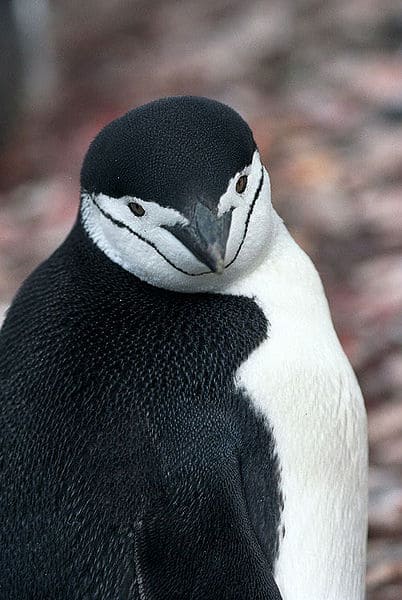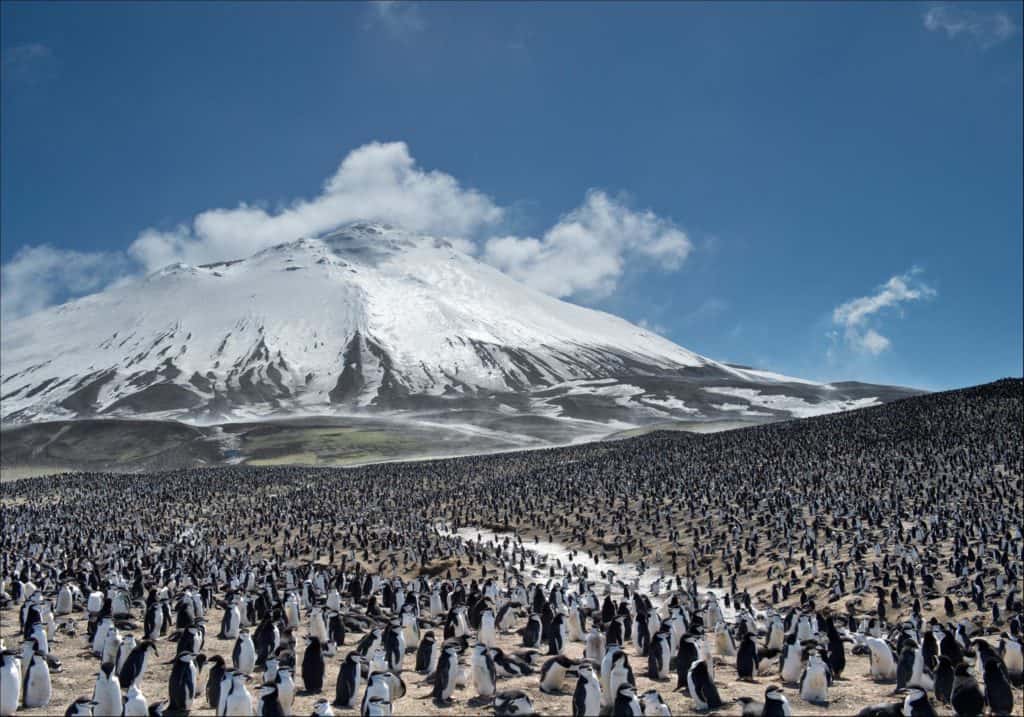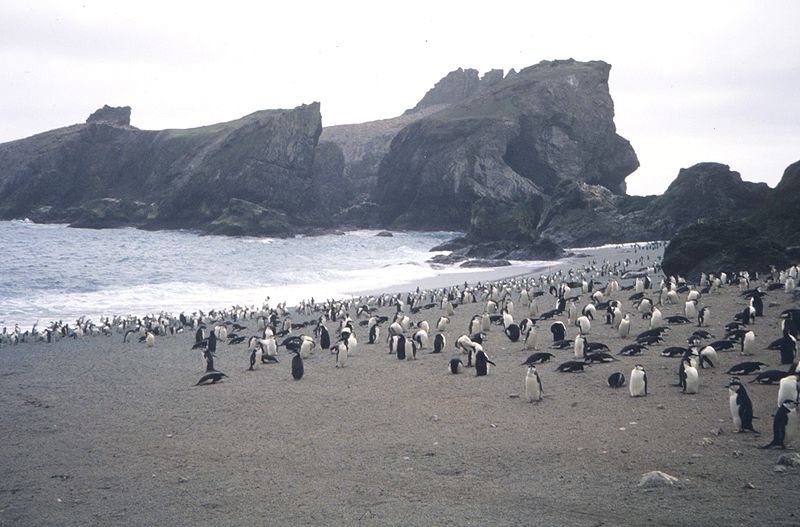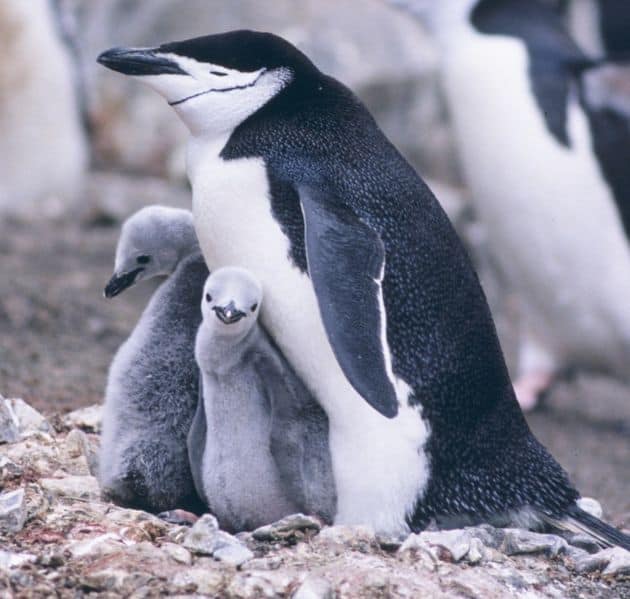The Southern Pacific and Antarctic oceans are home to various islands and shorelines where the Chinstrap penguin (Pygoscelis antarcticus) can be found. It gets its name from the thin black band that runs under its head, giving the impression that it is donning a black helmet and making it simple to spot. The chinstrap penguin, when developed, is between 27 to 30 in (68 and 76 cm) long and 7.1 to 11.7 lb (3.2 and 5.3 kg) in weight, depending on the season. Males are taller and heavier than females. Here are 10 incredible facts about the chinstrap penguin!
1. Chinstrap Penguins Live In One Main Area

Chinstrap penguins are a common species in the Antarctic and sub-Antarctic regions.
©Jerzy Strzelecki, CC BY 3.0, via Wikimedia Commons – License
The Antarctic Peninsula and islands in the South Atlantic Ocean are the primary breeding grounds for chinstrap penguins. South of New Zealand, on the Balleny Islands, there is a small breeding population. In the Antarctic and sub-Antarctic regions, chinstrap penguins are a common species.
2. They Share Territories With Other Species Of Penguins

Naturally, with so many species, there are occasional arguments about who owns the nests.
©MZPHOTO.CZ/Shutterstock.com
Even though Chinstrap penguins have the typical black and white coat of this type of flightless bird, one feature makes it simple to distinguish them from the other 16 types of penguin. They have a black line on their face that joins at eye level from both sides of the head.
Naturally, with so many species, there are occasional arguments about who owns the nests. They are peaceful animals that get along well with one another, dwell in colonies, and generally coexist peacefully. However, there are disagreements every now and then during mating season.
3. Chinstrap Penguins Are Great Swimmers
This courageous penguin, inhabiting the South Pacific and the Antarctic, can swim up to 20 mph. Their feet and wings, commonly referred to as “flippers,” are extremely useful. While their flippers are of little help to them on land, they act as propellers underwater, enabling them to move ahead and accelerate remarkably.
The birds frequently slide on their stomachs while on land, propulsion coming from their feet and flippers. They primarily dive to feed, with some frolicking thrown in.
Although they can dive 230 feet, the typical dive is only 50 to 100 feet deep, and the average dive lasts only 20 seconds. When hunting, chinstrap penguins are quick and effective, diving for about one to three minutes at depths between 69 and 138 feet.
4. Chinstrap Penguins Live In Large Groups

Although chinstrap penguins can dive 230 feet, the typical dive is only 50 to 100 feet deep, and the average dive lasts only 20 seconds.
©Lt. Philip Hall, NOAA Corps, Public domain, via Wikimedia Commons – License
The majority of chinstraps’ lives are spent in colonies known as rookeries. Together, these groups nest, swim, eat and live. There may be up to 1,000 penguins or more in these sizable groupings at times. The northernmost portion of the Antarctic Peninsula and the sub-Antarctic islands are home to this species.
5. Their Numbers Are In The Millions
Although they have been observed to colonize on big icebergs drifting in the ocean, they reside in Antarctica on cliffs. They stand around two feet tall and weigh about ten pounds. These penguins are thought to number around about a million; however, some estimates put the number at only 7 million.
6. They Have A Cool Nickname Based On Their Loud Shrieking Noise

Because penguin vocalizations can be uniquely identified, chinstrap penguin mates can recognize one another and their chick.
©Lt. Philip Hall, NOAA Corps, Public domain, via Wikimedia Commons – License
This penguin is frequently referred to as a “Stonebreaker Penguin,” not because it gathers stones for its nest but because it makes a screech so powerful that it can break stones. One of the boldest and most aggressive penguin species in the entire globe is this bird.
Because penguin vocalizations can be uniquely identified, mates can recognize one another and their chick. This is crucial since it might be difficult to distinguish amongst penguins in a large colony just by looking at them. Male and female penguin cries have been found to differ in research.
7. Chinstrap Penguins Can Be Extremely Aggressive
In their breeding areas, chinstrap penguins are incredibly social creatures and frequently roost in groups, occasionally with Adélie penguins on sea ice. Chinstrap penguins spend most of their lives at sea, where they eat krill and small fish like other penguins, and they are thought to be the most combative penguins.
8. Chinstrap Penguins Mate For Life

Chinstrap penguins typically stay with the same spouse yearly, exhibiting monogamy.
©US National Oceanic and Atmospheric Administration / Public domain, via Wikimedia Commons – License
Most penguins only have one partner. This indicates that throughout the mating season, male and female pairs will only mate with one another. The male and female will frequently continue to mate for most of their lives.
They are lifelong partners and non-flying birds, and they make excellent parents. Chinstrap penguins typically stay with the same spouse yearly, exhibiting monogamy. Each year, they return to the land to establish colonies, sometimes with more than 100,000 adult pairs.
9. They Have A Much Better Chance Of Survival In Captivity
In the wild, they can live up to 15 years, while in captivity, they can live up to 20 years. The leopard seal poses the biggest threat to the adults among its many predators, and they can swim covertly on the ice thanks to their white bellies. Due to their small size and inability to fend off predators, baby chicks and eggs are vulnerable to being eaten by birds.
10. Both Male And Female Play A Big Role In Nesting

The young birds of the chinstrap penguin stay with their parents for around three weeks after hatching.
©Lt. Philip Hall, NOAA Corps, Public domain, via Wikimedia Commons – License
On dry land, the eggs are placed in nests. Both the males and the females help build the nest. They use rocks to create a circular area for their nest. Each clutch contains 2 eggs laid by the female. Usually, only one egg makes it, and the other one dies.
Their eggs take approximately 35 days to incubate. The young birds stay with their parents for around three weeks after hatching. Mom and dad alternate sitting on the eggs for up to 5 days throughout the incubation phase. Both parents are in charge of incubating the eggs.
Related Animals:
The photo featured at the top of this post is © robert mcgillivray/Shutterstock.com
Sources
- Wikipedia, Available here: https://en.wikipedia.org/wiki/Chinstrap_penguin
- Britannica, Available here: https://www.britannica.com/animal/chinstrap-penguin
- Penguins World, Available here: https://www.penguins-world.com/chinstrap-penguin
Thank you for reading! Have some feedback for us? Contact the AZ Animals editorial team.






